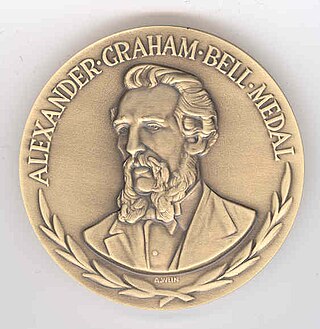
The NASA Distinguished Service Medal is the highest award that can be bestowed by the National Aeronautics and Space Administration of the United States. The medal may be presented to any member of the federal government, including both military astronauts and civilian employees.

The Silver Buffalo Award is the national-level distinguished service award of the Boy Scouts of America. It is presented for noteworthy and extraordinary service to youth on a national basis, either as part of, or independent of the Scouting program. The award is made by the National Court of Honor and the recipient need not be a registered member of the BSA.
The J. J. Ebers Award was established in 1971 to foster progress in electron devices. It commemorates Jewell James Ebers, whose contributions, particularly to transistors, shaped the understanding and technology of electron devices. It is presented annually to one or more individuals who have made either a single or a series of contributions of recognized scientific, economic, or social significance in the broad field of electron devices. The recipient is awarded a certificate and check for $5,000, presented at the International Electron Devices Meeting.
Arun N. Netravali is an Indian–American computer engineer credited with contributions in digital technology including HDTV. He conducted research in digital compression, signal processing and other fields. Netravali was the ninth President of Bell Laboratories and has served as Lucent's Chief Technology Officer and Chief Network Architect. He received his undergraduate degree from IIT Bombay, India, and an M.S. and a Ph.D. from Rice University in Houston, Texas, all in electrical engineering. Several global universities, including the Ecole Polytechnique Federale in Lausanne, Switzerland, have honored him with honorary doctorates.
IEEE W.R.G. Baker Award provided by the Institute of Radio Engineers (IRE), was created in 1956 from a donation from Walter R. G. Baker (1892–1960) to the IRE. The award continued to be awarded by the board of directors of the Institute of Electrical and Electronics Engineers (IEEE), after the IRE organization merged into the IEEE in 1963. Recipients received a certificate and honorarium "for the most outstanding paper reporting original work" in one of the IEEE publications, including the transactions, journals, proceedings, and magazines of the IEEE Societies. The award was discontinued in 2016.

The NASA Exceptional Scientific Achievement Medal was established by NASA on September 15, 1961, when the original ESM was divided into three separate awards. Under its guidelines, the ESAM is awarded for unusually significant scientific contribution toward achievement of aeronautical or space exploration goals. This award may be given for individual efforts that have resulted in a contribution of fundamental importance in this field, or have significantly enhanced understanding of this field.
The William H. Twenhofel Medal is the highest award given by the Society for Sedimentary Geology (SEPM). It was instituted in memory of William H. Twenhofel and is awarded annually to a person for his or her "Outstanding Contributions to Sedimentary Geology."
The IEEE Edison Medal is presented by the Institute of Electrical and Electronics Engineers (IEEE) "for a career of meritorious achievement in electrical science, electrical engineering, or the electrical arts." It is the oldest medal in this field of engineering. The award consists of a gold medal, bronze replica, certificate, and honorarium. The medal may only be awarded to a new leap/breakthrough in the technological area of science.

The IEEE Alexander Graham Bell Medal is an award honoring "exceptional contributions to communications and networking sciences and engineering" in the field of telecommunications. The medal is one of the highest honors awarded by the Institute of Electrical and Electronics Engineers (IEEE) for achievements in telecommunication sciences and engineering.
The initially called Morris Liebmann Memorial Prize provided by the Institute of Radio Engineers (IRE), the IEEE Morris N. Liebmann Memorial Award was created in 1919 in honor of Colonel Morris N. Liebmann. It was initially given to awardees who had "made public during the recent past an important contribution to radio communications". The award continued to be awarded as the IEEE Morris N. Liebmann Memorial Award by the board of directors of the Institute of Electrical and Electronics Engineers (IEEE) after the IRE organization merged into the IEEE in 1963. The scope was changed to "for important contributions to emerging technologies recognized within recent years". After 2000, the award was superseded by the IEEE Daniel E. Noble Award.
The IEEE Cledo Brunetti Award is an award is presented for outstanding contributions to nanotechnology and miniaturization in the electronics arts. It may be presented to an individual or a team of up to three. The award was established in 1975 by the IEEE Board of Directors.
The IEEE Herman Halperin Electric Transmission and Distribution Award is a Technical Field Award of the IEEE that is presented for outstanding contributions to electric transmission and distribution. The award may be presented annually to an individual or a team of up to three people. It was instituted by the IEEE Board of Directors in 1986.
The IEEE Richard Harold Kaufmann Award is a Technical Field Award of the IEEE that was established by the IEEE Board of Directors in 1986. This award is presented for outstanding contributions in industrial systems engineering.
The IEEE Haraden Pratt Award was established by the IEEE Board of Directors in 1971 in honor of Haraden Pratt. This award is presented to recognize individuals who have rendered outstanding volunteer service to the IEEE.
The George Westinghouse Medal is named for George Westinghouse and awarded to in honor of "eminent achievement or distinguished service in the power field of mechanical engineering" by the American Society of Mechanical Engineers. There is a Gold medal and a Silver medal. The silver medal may only be awarded to someone under 45 years of age.
The O.E. Meinzer Award is the annual award of the Hydrogeology Division of the Geological Society of America. Established in 1965, it is named after Oscar Edward Meinzer who has been called the "father of modern groundwater hydrology". The Meinzer award recognizes the author or authors of a publication or body of publications that have significantly advanced the science of hydrogeology or a closely related field.
The John Fritz Medal has been awarded annually since 1902 by the American Association of Engineering Societies (AAES) for "outstanding scientific or industrial achievements". The medal was created for the 80th birthday of John Fritz, who lived between 1822 and 1913. When AAES was dissolved in 2020, the administration of the Fritz medal was transferred to the American Institute of Mining, Metallurgical, and Petroleum Engineers (AIME), and is currently coordinated by AIME member society, the Society of Mining, Metallurgy, & Exploration (SME).
The Wilbur Cross Medal, or Wilbur Lucius Cross Medal for Alumni Achievement, is an award by the Yale University Graduate School Alumni Association to recognize "...distinguished achievements in scholarship, teaching, academic administration, and public service..."
The Eli Lilly Award in Biological Chemistry was established in 1934. Consisting of a bronze medal and honorarium, its purpose is to stimulate fundamental research in biological chemistry by scientists not over thirty-eight years of age. The Award is administered by the Division of Biological Chemistry of the American Chemical Society.



